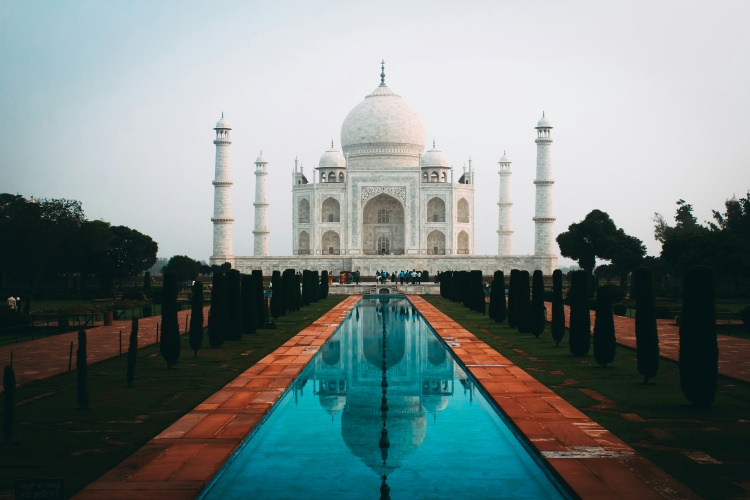India’s rich cultural heritage and vast historical landscape make it a dream destination for travelers seeking to explore ancient monuments and landmarks. Winter, with its pleasant weather and clear skies, is the ideal time to visit these iconic sites. From majestic forts and temples to awe-inspiring palaces and tombs, India’s history is etched in stone, and these landmarks offer a glimpse into the past while captivating visitors with their grandeur. Here’s a look at the top five historical landmarks in India to visit this winter season.
1. Taj Mahal, Agra
The Taj Mahal is undoubtedly India’s most famous historical landmark and a symbol of eternal love. Located in Agra, this majestic white marble mausoleum was commissioned by Mughal Emperor Shah Jahan in memory of his wife Mumtaz Mahal. Recognized as a UNESCO World Heritage Site, the Taj Mahal is admired for its architectural beauty, symmetry, and the emotional story behind its creation.
- Best Time to Visit: The best time to visit the Taj Mahal is between October and March, when the weather is cool and pleasant, making the experience more enjoyable.
- How to Reach: Agra is well-connected by road, rail, and air. The nearest airport is Agra Airport, about 13 km from the Taj Mahal. You can also take a train from Delhi or other major cities to Agra.
- Local Attraction: While in Agra, don’t miss the Agra Fort, a UNESCO World Heritage Site, or the Tomb of Itimad-ud-Daulah, known as the ‘Baby Taj.’ Additionally, the Fatehpur Sikri ruins are just a short drive away.
2. Qutub Minar, Delhi
The Qutub Minar, an iconic structure in Delhi, stands tall at 73 meters, making it one of the tallest brick minarets in the world. Built in 1193 by Qutb-ud-Din Aibak, the Qutub Minar is a stunning example of Indo-Islamic Afghan architecture. Its intricate carvings and inscriptions make it a significant piece of India’s history, representing the beginning of Muslim rule in India.
- Best Time to Visit: Winter (October to March) is the perfect time to explore the Qutub Minar due to the cooler weather, which enhances the experience.
- How to Reach: The Qutub Minar is located in Mehrauli, South Delhi, and is easily accessible via metro (Qutub Minar Station on the Yellow Line), bus, or taxi from various parts of Delhi.
- Local Attraction: While visiting the Qutub Minar, explore the Qutub Complex, which houses the Iron Pillar of Delhi and other historical ruins. The nearby Mehrauli Archaeological Park is also worth a visit.
3. Jaipur City Palace, Jaipur
Jaipur, the ‘Pink City,’ is home to several architectural marvels, and the City Palace stands as one of its most striking landmarks. The City Palace, a fusion of Rajput and Mughal architecture, was built by Maharaja Sawai Jai Singh II in the 18th century. The palace complex consists of courtyards, gardens, museums, and royal apartments that reflect the grandeur of Rajasthan’s royal heritage.
- Best Time to Visit: The best time to visit Jaipur is during the winter months, from November to March, when the temperatures are mild and comfortable for sightseeing.
- How to Reach: Jaipur is well-connected by air, rail, and road. The Jaipur International Airport serves domestic and international flights. The City Palace is located in the heart of the city and can be easily reached by taxi, auto-rickshaw, or bus.
- Local Attraction: Other must-see attractions in Jaipur include the Hawa Mahal, Amber Fort, and Jantar Mantar. The local bazaars, such as Johari Bazaar and Bapu Bazaar, offer a delightful shopping experience for souvenirs.
4. Red Fort, Delhi
The Red Fort, a UNESCO World Heritage Site, is a stunning example of Mughal architecture and one of the most visited landmarks in India. Built by Emperor Shah Jahan between 1638 and 1648, the fort served as the main residence of Mughal emperors for nearly 200 years. Its imposing red sandstone walls, intricate carvings, and vast courtyards tell the story of India’s Mughal legacy.
- Best Time to Visit: Winter is the ideal time to explore the Red Fort, as the weather is cool, making it easier to navigate the expansive fort complex.
- How to Reach: The Red Fort is located in the heart of Old Delhi. It is easily accessible via metro (Chandni Chowk or Red Fort metro station) or by road.
- Local Attraction: Nearby attractions include Jama Masjid, Chandni Chowk, and Raj Ghat. You can also visit the India Gate and Humayun’s Tomb, both showcasing India’s colonial and Mughal past.
5. Mysore Palace, Mysore
Mysore Palace, also known as the Amba Vilas Palace, is one of the most majestic palaces in India. It is the official residence of the Wodeyar family and a fine example of Indo-Saracenic architecture. The palace is adorned with stunning interiors, including intricate woodwork, stained glass windows, and elaborate frescoes. The grandeur of the palace, combined with its historical significance, makes it a must-visit during the winter season.
- Best Time to Visit: The best time to visit Mysore is from October to March, with temperatures ranging between 15°C to 25°C, perfect for exploring the palace and the city.
- How to Reach: Mysore is well-connected by rail, road, and air. The nearest airport is the Mysore Airport, while the city is easily reachable from Bangalore (around 140 km) by bus, taxi, or train.
- Local Attraction: While in Mysore, visit the Chamundeshwari Temple atop Chamundi Hill, St. Philomena’s Church, and the nearby Brindavan Gardens. The Mysore Zoo is another popular family destination.
India’s historical landmarks offer a window into the past, providing travellers with a chance to explore the country’s diverse heritage and cultural richness. Winter is the best season to visit these iconic sites, with its favorable weather enhancing the sightseeing experience. Whether it’s the Taj Mahal’s romantic beauty, the Qutub Minar’s towering presence, or the majestic Mysore Palace, each landmark tells a story of India’s glorious history that continues to captivate visitors year after year. Winter Season






3 thoughts on “India’s 5 Most Popular Historical Landmarks to Visit This Winter Season”
Comments are closed.